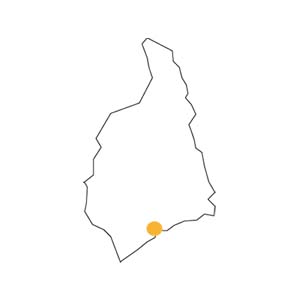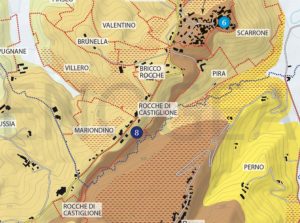Rocche di Castiglione
Castiglione Falletto, Monforte d'Alba
Rocche di Castiglione is a good example of why an aerial view can be very useful, because on the ground there are few vantage points from which to enjoy an almost complete panorama of this MGA (only along the narrow road that descends from Perno toward Cappallotto).
Before going into detail about this MGA, however, I’d like to answer a question: what is the origin of the word ‘rocche’ so often used in the Langhe? That’s easy, because the answer is right before your eyes.
By rocche (strictly in the plural, never singular) we mean those sheer cliffs that often mark the contours of these hills. Sometimes they can be very evident, as here at Rocche di Castiglione, sometimes barely visible and sometimes almost completely covered with woods. When visible, they help us to understand the structure of the associated geological formations, which can be the Diano Sandstones, as in this case, the Sant’Agata Fossili Marls or a combination of the two. To view the rocche originating from the Lequio Formation, instead, you need to go toward Sinio, a village in the hills, or , to stay in the Nebbiolo area, to the southern part of Treiso, in the Barbaresco zone.
At Rocche di Castiglione, the soils of the entire vineyard slope, contrary to what one might expect, originate from a layer of sandy Sant’Agata Fossili Marls that overlaps, without being visible, that of Diano Sandstones. The only exception is Lipulot, an area historically considered independent and incorporated in the Rocche di Castiglione MGA at the time of the official definition of the boundaries. There the soils are an expression of Diano Sandstones, which take on a more of an ocher color than those visibile under the Rocche di Castiglione proper. (This can be easily observed both from the Lipulot border with the Pira MGA and in the center of the town of Castiglione Falletto, as already mentioned in the Landscape and Soils section).
But that’s not all: Lipulot is the only area of Rocche di Castiglione with a southern exposure and it is also the only one that to date has not had a Barolo vinified on its own. So it’s hard to say whether the particularities highlighted so far translate into comparable differences in the wines.
Still on the subject of soils, in the area near the border with Monforte d’Alba and up to the central part of the MGA they generally have a rather loose and sandy texture, while in the next area and as far as the small wood that dominates the Pira vineyards they have a more marly character. Along the same course, the undulating contours of the slope also cause slight fluctuations in the generally southeastern exposure of the vineyards. These oscillations, even though linked with the different traits of the terrain, are not sufficient to cause equally significant and repeatable variations in the character of the wines, which are marked by a style of perfumed and refined elegance.
Recommended tastings
Barolo Rocche di Castiglione – Brovia; Barolo Rocche di Castiglione – Fratelli Monchiero; Barolo Rocche di Castiglione – Vietti
Reference tastings
Barolo Villero – Brovia; Barolo Scarrone Vigna Mandorlo – Fratelli Giacosa; Barolo Brunate – Vietti




